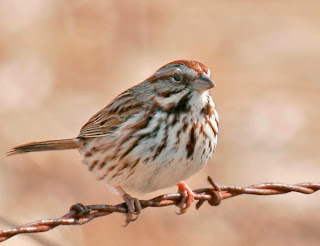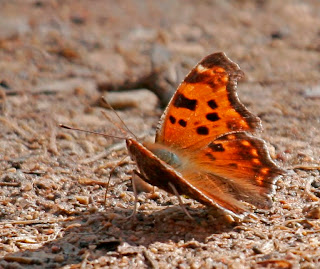I was sitting in the Prius with Tom, listening to Sandhill Cranes bugling in the corn fields along the Lower Chippewa River at Meridean. I heard a familiar song that I hadn't heard in months. I had to pause.
Who was it? Click on this link to listen.
I had to pull out my iPod and connect it to my Prius audio system so I could confirm it by listening to the song on my BirdJam playlist.
While I was listening to my iPod through the car radio, this little Song Sparrow flew right over and perched on the barbed wire fence across from me. He stared at my car and seemed puzzled by the very loud Song Sparrow song emanating from it.
I'd forgotten how much fun it was to drive the stealth Prius with the windows down. It is the best vehicle for watching, listening to and photographing birds (butterflies and other wildlife). When I put my foot on the brake, the engine shuts off. No noise. No shake.
Despite all the hoopla about the brakes, today's wildlife expedition was a reminder of why I bought a Prius. I drove 42 miles and I got 67 MPG. What a great car!
I had to laugh at my experiences with butterflies and moths today. I'd see one and stop; put the Prius in "park;" then hop out. The minute I got out of the car, the butterflies would fly off.
However, if I stayed in the car, they ignored me.
I wasn't sure at first what this species was. When I got home and processed my photos, I saw the distinctive "comma" on the under-wing: an Eastern Comma.
The Eastern Comma and the Mourning Cloak both over-winter as adults by hibernating. Although they may also migrate, the Mourning Cloaks are known for their roaming. Both are often seen out on warm days in late winter and early spring.
The overwintering Comma adults will fly and lay eggs in the spring until April. The larval food plants are wood nettles, false nettles, hops and American elm. The adults feed on rotting fruit and tree sap. Look for both feeding at sapsucker holes in March.
Adult Mourning Cloaks prefer tree sap - especially oaks - and they feed like a nuthatch - head down on tree trunks.
Their larval plants are willows, American elm, hackberry, paper birch, cottonwood and aspen. Adults will encircle twigs with eggs. Mourning Cloak caterpillars hatch and share a communal web, feeding on young leaves.



No comments:
Post a Comment